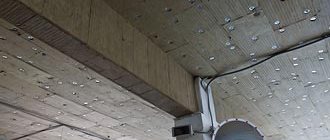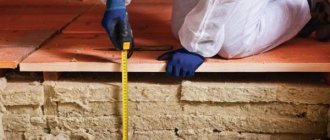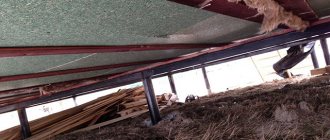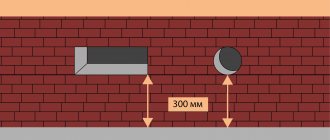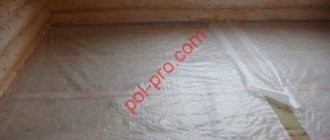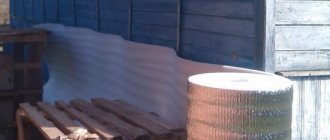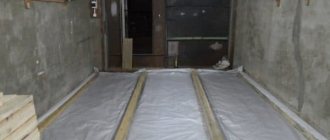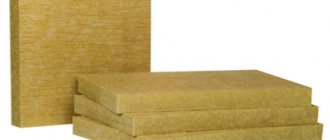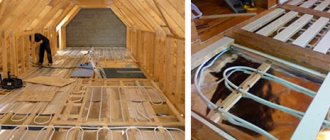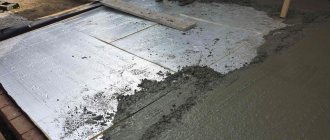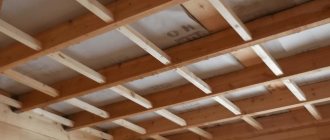Wooden houses are considered thermally efficient, since wood conducts heat poorly. However, in practice, everything turns out the other way around. The material dries out and cracks, causing the cold to penetrate inside faster.
Floors are made mainly using frame technology, so layers of insulation must be laid inside them. The thickness of the floor insulation in a wooden house depends entirely on the selected heat insulator.
Laying mineral wool - not the best quality work
Floor insulation width
In terms of the scale of heat loss, the floor can be compared to energy-inefficient windows.
10-15% of heat is lost through uninsulated floors and basements. Insulating the floor in a private house reduces this leakage to almost zero. The room will be more comfortable and you won’t have to overpay for heating. In addition to reducing heat loss, insulation in a floor structure also often serves as sound insulation. Moreover, it is the protection against impact noise that can become the main reason for using ISOVER products when arranging floors.
Impact noise protection is a complex task. Effective floor insulation can be done in two ways: installing a “floating floor” or installing a floor using joists.
Floors with joists: requirements, design, features of installation of thermal insulation
How to lay insulation on floors along joists
| The floor screed is covered with a layer of waterproofing or a vapor barrier membrane. In the case of membrane covering, it is necessary to overlap at least 10 cm so that the insulation of the floor in an apartment or house does not have gaps. And the joints of the vapor barrier membrane are taped with adhesive tape. ISOVER VS 80 vapor barrier and ISOVER Vario KB 1 tape or ISOVER VarioDoubleFit sealant are suitable for installation. | |
| Next, the beams are installed in increments of 500 mm. The result is a frame for further work. | |
| After this, the thermal insulation roll is opened and cut into 510 mm wide slabs. (The width of the thermal insulation slab is 10 mm greater than the distance between the joists), then the insulation is placed between the frame elements at random. | |
| A layer of vapor barrier membrane is laid on top of the placed thermal insulation. In this case, the inscriptions on the membrane must be on the outside. The joints of the canvases and the lumbago are also taped with adhesive tape. | |
| After this, the second frame layer is mounted perpendicular to the main layer. In this case, the pitch is 400 mm. After this, thermal insulation is placed in the gaps between the frame elements. The slabs are cut from a roll, and their width is 410 mm - 10 mm more than the distance between the logs. | |
| The installation work is completed by fixing the external finishing coating. The pictures show the insulation of a wooden floor. |
Useful tips
- A vapor barrier will protect the insulation and structural elements from being moistened by water vapor that goes into the room. Always install a vapor barrier on the inside of the insulation (the one facing the inside of the room). Thus, in the case of attic insulation, the vapor barrier is installed under the insulation, and in the case of floor insulation above the basement, it is installed on top of the insulation.
- Lay the insulation as a continuous sheet, without gaps or cracks. Carefully ensure that the layers of thermal insulation are joined tightly to each other and fit closely to the structural elements.
Floating floor: requirements, design, installation features of thermal insulation
As with any other floor system, a “floating floor” is subject to two physically contradictory requirements. We are talking about high sound insulation ability and the ability to withstand high operating loads without changing technical and physical characteristics. Much in this case depends on the damping properties of the layer of elastic material used in the structure.
About ISOVER FloatingFloor
ISOVER FloatingFloor improves the sound insulation characteristics of reinforced concrete slab floors, and it can also be used to insulate the ground floor floor.
ISOVER Floating Floor is a non-combustible material, therefore the use of such insulation does not change the fire safety class of the building.
How to install insulation in floating floor structures
| The slabs are laid end-to-end on the prepared surface so that the longitudinal edge of the slab with the edge joins the next slab with a tongue-and-groove edge (if the tongue-and-groove connection is provided for by the design of the slab). Thus, the plates will be securely connected to each other. | |
| If you plan to use a cement-sand mortar to level the surface, lay a layer of waterproofing on top of the insulation with a 10 mm overlap. After this, a reinforcing mesh is laid on top. | |
| Next, the screed mixture is poured on top. Using beacons and a two-meter rule, the floor surface is leveled. | |
| Once the screed has dried, you can lay the finished floor. |
Choose ISOVER materials and insulate your concrete floor
You can find the necessary materials in your city. Request detailed information on where to purchase ISOVER thermal insulation near your home.
How to insulate the floor in a frame house on a slab foundation
To insulate a floor on a slab foundation, you must:
- We attach waterproofing to the foundation slab, extending onto the walls.
- We fasten the logs.
- We fix insulation between the joists, on top of which waterproofing is installed.
- We mount boards, plywood or OSB boards onto the film.
- We lay a substrate of foamed polyethylene or pine needles on top, and then the finished floor.
To insulate floors on slab foundations, I most often use expanded polystyrene. The main thing is that it has a self-extinguishing property.
Criteria for choosing thermal insulation for floors
Thermal insulation of the floor is done, if not for the entire life of the house, then for a very long time - two to three decades or more. Therefore, the choice of insulating materials should be taken as seriously as possible. To answer the question of which insulation to choose for the floor, let’s name its main characteristics that you need to pay attention to first. Among them:
- thermal conductivity - this parameter indicates the amount of heat loss in watts per square meter of surface; the lower its value, the warmer the coating will be;
- indicators of the release of volatile compounds, which determine the degree of environmental safety of products;
- density in kilograms per cubic meter, on which the resistance of the insulation to vertical loads depends; with increasing density, thermal conductivity also deteriorates;
- flammability group (class) - according to this indicator, products are divided into five categories: highly, normally, moderately, weakly and non-flammable products;
- water absorption - this indicator indicates the amount of moisture that the insulation can hold and determines its water resistance;
- vapor permeability - the ability of the insulating layer to dry after getting wet and allow water vapor to pass through it depends on it;
- durability - service life is determined by the manufacturer based on the results of laboratory tests of products and indicates them in the technical documentation, the same applies to the resistance of thermal insulation to aggressive influences, biological contaminants and pests;
- applicability – these are the manufacturer’s recommendations for the use of products, which can be universal and highly specialized.
Manufacturers
Many companies are engaged in the production of materials for floor insulation. Among them are world-famous brands and those who are just starting their journey. Most of the companies have almost a century of history. To help you make your choice, below is a rating of the most popular manufacturers. All of them present materials with proven quality.
- Knauf. The international manufacturer has over 90 years of experience. Insulation materials are popular all over the world. The products are made from natural raw materials using the latest technologies. All insulation materials are environmentally friendly and harmless. Knauf has been a leader in the market for many years.
- Rockwool. The company works using modern technologies and specializes in basalt thermal insulation materials. The advantage of this raw material is its high performance and affordable price. In Russia, branches are located in the Moscow, Chelyabinsk and Leningrad regions. The company is in second place in the ranking of manufacturers of insulation materials.
- Paroc. The company also specializes mainly in the production of mineral wool. Time-tested quality. The manufacturer focuses on saving thermal energy for heating living spaces and excellent sound insulation. But the disadvantage of this company is that all insulation products have a fairly high price. That is why the company ranks third.
- Isover. The manufacturer focuses on the production of mineral wool and offers two solutions - glass wool and stone wool. This is a distinctive feature of the manufacturer, since both options are often used in construction. The materials have high elasticity and strength. According to their characteristics, mineral wools of this brand are the best. There is a good price-quality ratio here.
- Ursa. The company works using new technologies and offers both mineral wool and fiberglass. Product prices are affordable. The company recently entered the Russian market, so it is not yet very widespread. But, thanks to prices that are significantly lower than the prices of other market representatives, there is a demand for the products.
Some calculation tips from a professional
The dimensions of a mineral wool slab are usually determined in order to understand how much material is required. Despite its apparent simplicity, this operation often causes problems for many inexperienced people. They end up buying too little (or too much) insulation. In any case, this entails inconvenience. To avoid fatal mistakes and always buy the correct amount of mineral wool, you should follow simple principles:
- Most insulation packages (if we are talking about certified products) indicate the area of the roll (in m2). This data will allow you to determine how many rolls are required.
- It must be remembered that mineral wool shrinks. In addition, it is advisable to lay it in excess (for better density and, as a result, getting rid of cracks). Therefore, you need to add a few percent to the resulting calculations.
- To achieve maximum savings in insulation, you should compare its dimensions in advance. That is, the distance between the logs must be made exactly the width of the mineral wool (not forgetting about 1-2 cm of technical excess).
- It must be remembered that mineral wool packages from different manufacturers (even if they are the same brands) may differ in size. In such cases, it is necessary to check the area of each roll.
In general, the algorithm for finding the required amount of mineral wool (or other insulation) is as follows:
Important! We are looking at the process of insulating the entire house (i.e. floor, walls and ceiling). If we are talking about thermal insulation of specific parts of the building, then the algorithm is reduced.
Preparatory work
Logs for laying floor insulation
Before starting insulation, it is necessary to carry out a number of measures to prepare load-bearing structures and surfaces for long-term insulation. This is necessary to prevent the development of corrosion and rotting of materials located in a place inaccessible to inspection.
Sequencing:
- Remove the old covering. It must be disassembled carefully so as not to damage the supporting structures.
- Inspect the wood, mark areas damaged by mold. Remove rot and strengthen these areas if necessary.
- Treat the structure with a fire retardant, antiseptic and hydrophobic agent.
- If access to the supports or foundation is subsequently closed, equip them with waterproofing and cover them with insulation.
Soundproofing of interior partitions
We use Technoacoustic slabs 50 mm thick with double-sided plasterboard sheathing on a metal or wooden frame.
- We install the wall frame (wooden beams or metal profile) with a distance between the beams inside of 580-590 mm.
- On one side we cover the wall with OSB sheets, fiberboard or plasterboard.
- We lay stone wool.
- We lay the second layer of insulation with a seam spacing of 150 mm.
- We cover the insulation with sheets for finishing. We fix the sheets to the frame.
Attic insulation
Roof insulation between rafters is the most common method of thermal insulation. It can be done outside or inside.
- We lay the roof covering.
- We ensure good ventilation of the structure due to a 50-80mm wide ventilation gap separating the insulation from the final roofing covering. It is also necessary to install ventilation holes on the eaves, overhangs, ridges, and ridges and protect them from sliding snow.
- We prepare the hydro-windproof outer layer of the system by laying hydrofilm on top of the rafters.
- We lay insulation (for us it is TECHNONICOL Rocklight) in the space between the rafters. We make sure that the width of the insulation is 10-15% greater than the distance between the rafter legs. For example, if the width of the insulating board is 600 mm, then the distance between the rafters should be 580-590 mm.
- We sew an additional sheathing of timber with a cross section of 50*50 mm across the rafters.
- We lay the second layer of insulation with the joints spaced at least half their length.
- We cover the insulation with a vapor barrier film. We roll it out horizontally and fasten it with a construction stapler.
- We fasten the film sheets with acrylic tape for tightness.
- We lay the bases for finishing (leveling bars, OSB sheets, plywood, drywall).
Still have questions? Ask them to us in the comments.
Watch detailed video instructions on our YouTube channel:
Slab parameters depending on the area of use
Characteristics of slabs of different densities
Mineral wool is characterized by ease of installation and high performance - the dimensions and scope of application of the material depend on its rigidity. Manufacturers produce the following modifications:
- Lightweight - with a density from 10 to 35 kg/m3. With their help, frame buildings can be insulated and protected from noise.
- Elastic - density from 35 to 120 kg/m3. The insulation is suitable for walls, its dimensions can be adjusted to the configuration of buildings. Mineral wool can withstand minor external loads.
- Hard – the density indicator is 120-180 kg/m3, which is suitable for working with ventilation systems, organizing thermal protection of baths and industrial premises.
The width of the insulation is determined by the climatic characteristics of the region. Buildings in the southern regions are decorated with sheets 120-180 mm wide, in the central - from 180 to 240 mm, in the northern - up to 360 mm.
The final parameters are determined by the type of insulated object.
Facade slabs
Facade products eliminate the cost of materials during construction. They are attached to a supporting frame, have good vapor permeability, do not shrink, and do not deform when exposed to temperature.
The dimensions of a standard cut of mineral wool supplied in slabs are 100x50x5 cm. For facades with a non-standard configuration, material 120x60x20 mm is suitable.
Roofing slabs
The material parameters depend on the region in which the roof is insulated. You can calculate the parameters using an online calculator or yourself, taking into account the standards for the climate zone, the layer-by-layer thickness of the structure, and the thermal conductivity of each layer. When choosing manufacturers, you will need to take into account the type of roofing structure.
The pitched roof is insulated with materials PAROS UNS 37 (610x1220x50 mm) and Extra (250x50 mm), Knauf (5500x1200x150 mm), Rocklight (1000/2000-500/600-50/100 mm), Techno (100x60x5/10 mm), Izover ( 1170x610x50 mm), Isovat (1000x600x50/100 mm).
For flat structures, the best options would be the products PAROS Rob (1200/1800x600/900/1200 mm), Monrock Max (2000x1200x50/200 mm), Tekhnoruf N (1200x600x100 mm).
For work in attics and attics with height differences and complex configurations, rolled glass wool with a density of 11-15 kg/m3 is suitable.
For walls
The suitable size of slab mineral wool is 120 cm in length and 100 cm in width. The thickness of the product is 2.5-5 cm. The material is used for external and internal work, insulation of rooms with high humidity, ventilated facades and sandwich panels.
Rigid modifications with a density of 150 kg/m3 are suitable for installation on metal or reinforced concrete floors. For fire protection purposes, a material with a density of 200 kg/m3 is optimal.
Mineral wool is laid on walls vertically and horizontally.
For floor
You can insulate the floor from cold air using products with dimensions of 600x800 and a density of 100-150 kg/m3. The length and width are adjusted to the coating parameters.
Types of mineral wool for floor insulation
Mineral wool is produced in the form:
- rolls;
- solid slab, they are more often used when insulating floors on the ground or
- flexible mat.
- A flexible mat made of hydrophobized mineral wool is covered (laminated) with perforated kraft paper on one side. It is laid so that the laminated side faces the direction of the insulated room. The slabs are also made from a hydrophobized material, and their sides have different hardnesses. The stiffer side should be directed upward when laying the slabs. To avoid installation errors, it is marked in blue. These slabs are predominantly used for single-layer thermal insulation on the ground.
How to insulate the floor in a frame house on a pile foundation
Insulation of the floor of a frame house on stilts is carried out during the construction stage. Installation is simple, so you can do it yourself.
- I install logs made of rectangular timber on the piles.
- I attach the bars to the joists and lay the floor from the subfloor boards.
- I put insulation in the space between the joists up to its upper level.
- I am installing a vapor barrier.
- I lay the base - particleboard or plywood. This will help reduce thermal conductivity and ensure the reliability of the floor.
- I'm installing a finished floor.
If you need to insulate the floor in an existing frame house, first I “remove” the entire old floor, dismantle the sub-base, vapor barrier, waterproofing, and insulation.
It is no longer possible to reuse these materials, as the seal is broken.
Next, I carry out the work in the same way as described above.
Features of ceiling insulation
If the ceiling in a room is not insulated, there is a risk of fungus developing on it due to the formation of condensation. Ceiling insulation, the price of which depends on the material parameters (width, density, composition), has minimal thermal conductivity, good sound insulation and fire resistance. Thermal insulation is produced in the form of a flexible mat. A perforated layer is provided adjacent to the surface requiring insulation. Ceiling insulation in Yekaterinburg is available in rolls. Due to the absence of harmful components, the material is suitable for use in residential areas.
Waterproofing device
Material for waterproofing can be rolled, in the form of paints, deep penetration compounds and plaster. We install it on top of the insulation.
- After laying the thermal insulation and vapor barrier, we lay a cement-bonded or glass-magnesite board in two layers along the load-bearing joists.
- We make a cement-sand screed.
- After drying, prime the surface with a primer.
- We lay waterproofing (preferably rolled) in 1-2 layers.
- Fill with mortar 8 mm thick.
- We install the tile covering with glue.
The waterproofing process depends on the material from which the floor is made. Wooden products require the creation of a complex and reliable structure.
Extruded polystyrene foam
This modern floor insulation has universal properties:
- High thermal insulation properties.
- The ability to effectively muffle sounds.
- Expanded polystyrene practically does not absorb moisture, which allows it to be used under a cement screed.
- Also, expanded polystyrene has a high density and strength, does not burn, and is not susceptible to the formation of fungi and mold.
- Durability of the material: the service life of this floor insulation is more than 50 years.
Installation method
Expanded polystyrene is a fairly rigid heat insulator and can be used both under a cement screed and when insulating a wooden floor along joists:
- When installing insulation on a wooden floor, you should take into account the size of the polystyrene foam boards and install wooden sheathing with the appropriate spacing to ensure a tight fit of the heat insulator to the joists. Also, the thickness of the polystyrene foam is selected according to the height of the lag - there should be an air gap of about 1-2 cm between the heat insulator and the floor covering.
- To lay polystyrene foam under a cement screed, the base must be covered with a waterproofing layer. After installing the insulation on the floor, a reinforcing mesh is laid on top of it and a cement screed is poured, the minimum thickness of which should be 5 cm.
Advice! Extruded polystyrene foam has a high density, so if the room in which the concrete screed is poured is small, reinforcing mesh may not be used.
The best manufacturers
Insulation materials are produced by many well-known companies. Let's consider those of them that supply products with proven quality, and therefore are the most popular.
Knauf . This company, which has existed for more than 90 years, produces insulation materials that are popular all over the world, using innovative technologies and natural raw materials. All heat insulators (for example, the TeploKnauf brand) are safe and environmentally friendly.
Safe and environmentally friendly insulation materials TeploKnauf
Ursa . The manufacturer produces both mineral wool and fiberglass. The products are quite affordable. Ursa entered the domestic market relatively recently, and therefore the products of this brand are not very popular in our country yet. However, demand is constantly increasing due to low prices.
Ursa mineral wool is convenient and easy to install
Rockwool . One of the leaders in its segment, primarily engaged in the production of basalt insulation materials, characterized by affordable prices and excellent performance characteristics.
Rockwool company is one of the leaders in its segment
Isover . This company also focuses primarily on mineral wool and supplies stone and glass wool to the building materials market (which is good, because both options are often used in construction). Isover insulation materials are very durable and elastic, and are excellent value for money.
Isover company produces environmentally friendly materials that are safe for human health.
Paroc . Another manufacturer of insulation materials that specializes more in mineral wool (its quality has been tested over the years). The company focuses on saving heat when heating and effective sound insulation. But Paroc insulation is quite expensive, this is their main disadvantage.
Paroc insulation does not retain moisture and does not lose its properties when temperature changes
Video - Insulation testing: Rockwool, Teploknauf and Teploknauf NORD
Mineral wool insulation is the best choice for ceiling insulation
Particularly effective when insulating ceilings are materials based on mineral wool, which, having high heat and sound insulation characteristics, also have other positive qualities, thanks to which their use in premises, and above all, residential ones, is absolutely safe. This:
Ceiling insulation with mineral wool
- environmental friendliness of the material;
- absence of toxic substances in the composition;
- high fire safety;
- preventing the appearance of condensation, and, as a consequence, the development of fungi, mold and other microorganisms;
- durability;
- light weight;
- a variety of types of mineral wool products, which are produced in the form of rolls, slabs, and can also have a special foil layer, which simultaneously reduces thermal conductivity and protects the insulation from the influence of moisture.
Having given preference to Rockwool stone wool, it will be much easier to choose the appropriate material, since the product line of this manufacturer is quite wide and the appropriate product is used to insulate various building structures.
If you have work to insulate the ceiling, you should pay attention to Light Butts and Roof Butts.
To insulate the ceiling, our experts recommend:
Rockwool LIGHT BUTTS SCANDIC
Rockwool Acoustic Butts
URSA GEO M-11
Step-by-step instruction
Insulation is placed between the joists
Before starting repairs, you need to draw up a competent diagram. It will help you complete the job accurately and in the required sequence.
Step-by-step instructions for insulation:
Laying rough boards on the joists. They will be the basis and support for all subsequent layers. The cracks are sealed with polyurethane foam or tape. Laying a vapor-permeable membrane. It is necessary to remove moisture generated in the room. The fabric is fastened using a manual stapler with 6 mm staples. Creating a frame. The height of its walls should correspond to the thickness of the insulation. If a solution or bulk material is used, its layer must be at least 20 cm. Installation of thermal insulation. This procedure is performed in accordance with technology that is valid for each type of material
You should pay attention to the absence of cracks. Installation of waterproofing. Fabrics that conduct moisture in one direction are best suited for this.
The strips are overlapped with an overlap of 15-20 cm. The joints are fixed with tape. Laying the finished floor. The choice is determined by the type of finish. For linoleum, parquet and carpet, it is better to take inexpensive sheets of waterproof plywood 16-25 mm thick. Solid boards can be laid directly on the frame. In this case, you should take slats with selected edges so that there are no through gaps in the surface.
Floor insulation Knauf (Knauf)
Floor insulation
Like any other structure of a house, the floor and interfloor ceilings require high-quality insulation. This is primarily due to the fact that the air in the floor area is always colder, since warm air currents - according to the laws of physics - rise upward. Therefore, uninsulated floors reduce the comfort of living in a cottage and can cause colds. It’s not for nothing that popular wisdom advises “keep your feet warm and your head cold.” And the experience of professional builders suggests that high-quality floor insulation can improve the quality of life in a private home without installing expensive “warm floors”, in the presence of conventional radiator heating.
Sort by parameters:
Floor insulation – what are they?
For thermal insulation of floors, you can use various materials: expanded clay, cork and sawdust insulation, polystyrene concrete, mineral fiber, penoizol, EPS... They all have different heat-saving characteristics, operational properties, special installation principles, and different costs. But the most popular options today are mineral fiber boards or mats, as well as extruded polystyrene foam (EPS). If you are going to buy floor insulation , choose from these two options - they are more modern, energy efficient and easier to install.
General requirements
What characteristics should a modern safe and high-quality insulation have?
- Lightness . The insulation should not weigh down the building structure.
- Durability and reliability . Properly chosen material will definitely become a reliable support for the entire house.
- Safety . Mandatory requirement. It is important that the selected material fully complies with all sanitary standards and is non-toxic.
- Easy to install . Installing insulation should not be difficult.
- Low level of thermal conductivity . This is the main characteristic of the material, since its main functional purpose is to retain heat in the house.
- Density _ The higher the density of the material, the better it will protect your home from winter cold.
In the video - insulation for the floor in a wooden house:
